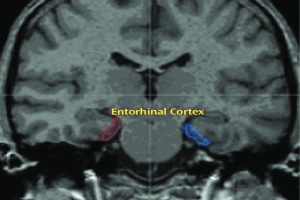New paper by Zach Reagh in Proceedings of the National Academy of Sciences. Congrats all around – this one was in the works for a good while!
Reagh, Z.M. & Yassa, M.A. (2014). Object and spatial mnemonic interference differentially engage lateral and medial entorhinal cortex in humans. PNAS doi: 10.1073/pnas.1411250111
Significance Statement:
Episodic memories are complex records of experience, consisting of “what” happened as well as “where” and “when” it happened. Animal studies have demonstrated distinct brain networks supporting memory for information about what experience occurred and information about where the experience occurred. However, such dissociations have been elusive in humans. Using a memory interference task that pits object (i.e., what) vs. spatial (i.e., where) memories against each other and high-resolution fMRI, we report evidence for two parallel but interacting networks in the human hippocampus and its input regions, supporting prior work in animals. We propose a conceptual model of how object and spatial interference are reduced in the regions providing input to the hippocampus, allowing rich, distinct memories to be built.
Abstract:
Recent models of episodic memory propose a division of labor among medial temporal lobe cortices comprising the parahippocampal gyrus. Specifically, perirhinal and lateral entorhinal cortices are thought to comprise an object/item information pathway, whereas parahippocampal and medial entorhinal cortices are thought to comprise a spatial/contextual information pathway. Although several studies in human subjects have demonstrated a perirhinal/parahippocampal division, such a division among subregions of the human entorhinal cortex has been elusive. Other recent work has implicated pattern separation computations in the dentate gyrus and CA3 subregions of the hippocampus as a mechanism supporting the resolution of mnemonic interference. However, the nature of contributions of medial temporal lobe cortices to downstream hippocampal computations is largely unknown. We used high-resolution fMRI during a task selectively taxing mnemonic discrimination of object identity or spatial location, designed to differentially engage the two information pathways in the medial temporal lobes. Consistent with animal models, we demonstrate novel evidence for a domain-selective dissociation between lateral and medial entorhinal cortex in humans, and between perirhinal and parahippocampal cortex as a function of information content. Conversely, hippocampal dentate gyrus/CA3 demonstrated signals consistent with resolution of mnemonic interference across domains. These results provide insight into the information processing capacities and hierarchical interference resolution throughout the human medial temporal lobe.
